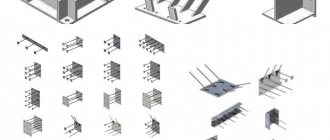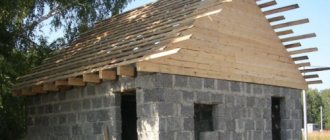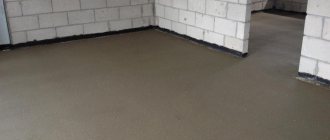Home |Types of concrete |Expanded clay concrete screed
Date: September 21, 2017
Comments: 0
Owners of country houses, apartments and cottages are united by the desire to have a perfectly flat and heat-insulated floor surface in their living space. To accomplish this task, expanded clay concrete is used, with which the screed is carried out. The basis of the material is environmentally friendly expanded clay granules produced by firing clay. Using granulated expanded clay, you can ensure the flatness of the base, insulate the floor, and also soundproof the room. Let's figure out how to do the work yourself.
Expanded clay concrete screed - properties and purpose
The properties of expanded clay concrete used for screeding differ significantly from the characteristics of cement-sand compositions. This is due to the use of granulated expanded clay in the mixture. The material is granules made by firing clay rock.
Expanded clay is a material widely used in the construction industry, both in the industrial sector and in the private sector
It is characterized by:
- cellular structure;
- light weight;
- increased strength.
These properties affect the performance characteristics, as well as the purpose of the expanded clay concrete base:
- ensuring reliable thermal insulation of the floor;
- effective absorption of extraneous noise;
- forming a solid base for the final coating.
The use of inexpensive and accessible material allows you to quickly form the rough surface of the floor and, if necessary, raise its level.
In a number of situations it is difficult to choose an alternative to an expanded clay concrete base:
- when planning a floor surface that has significant differences. In this situation, it is costly and problematic to compensate for height fluctuations of 15–20 cm using concrete;
- when carrying out repair work in buildings equipped with timber beams or weakened slabs. The material allows you to reduce the forces that are absorbed by floor panels and load-bearing beams;
- with a limited cost estimate for construction activities, as well as the inability to use significant volumes of Portland cement, crushed stone and gravel to carry out the work;
Expanded clay concrete is a building material based on expanded clay.
- if it is necessary to lay utility networks and heating communications in the thickness of the expanded clay massif, the dimensions of which do not allow installation in heavy concrete;
- when ensuring the flatness of bases of complex configuration, when with different layer thicknesses it is necessary to guarantee minimal shrinkage to ensure the strength of the final coating.
Due to its performance properties, the material is used to solve a wide range of problems.
Types of filler filling
Expanded clay screed is carried out using granules of all fractions. Pebbles have different sizes, volumes and weights.
| View | Fraction, mm | Weight, m3/kg |
| Expanded clay sand | up to 5 | 500-600 |
| Expanded clay fine gravel | 5-20 | 300-450 |
| Expanded clay crushed stone | 20-40 | 200-350 |
It is recommended to use several types of filler for the screed. This will ensure high performance properties of the coating. In stores, the material is packaged in bags weighing no more than 20 kg, which greatly simplifies transportation. The higher the density, the more the filler weighs. The prices for lifting the pillow depend on this.
Expanded clay concrete screed - advantages and disadvantages
Expanded clay concrete screed is widely used due to a number of undeniable advantages:
- increased thermal insulation characteristics;
- high level of sound protection;
- resistance to the development of fungi and mold;
- no negative impact on people's health;
- high safety margin;
- long service life;
- absence of cracks during temperature fluctuations;
- ease of independent arrangement;
- the ability to compensate for significant base errors;
- high compatibility with various types of coatings;
- fire safety;
- light weight;
- chemical resistance;
- resistance to moisture.
Expanded clay concrete is a type of lightweight concrete designed for thermal insulation and construction of various structures
Expanded clay concrete allows you to ensure the flatness of the following types of surfaces:
- horizontal;
- inclined;
- internal;
- external;
- residential;
- production
Thanks to these advantages, expanded clay concrete screed makes it possible to guarantee the formation of a strong base intended for long-term use of various types of finishing coatings.
Despite many advantages, the material is not without disadvantages. Weak spots:
- increased thickness of expanded clay concrete base;
- the need for additional work on polishing the floor;
- increased level of labor costs during concreting.
The material based on expanded clay granules is popular among novice builders, as well as professionals.
Proportions of expanded clay concrete for screed
Regardless of the method of performing the work, the composition of expanded clay concrete includes the following ingredients:
- Portland cement grade M400;
- sand cleared of impurities;
- granulated expanded clay;
- water.
Expanded clay concrete for screed can act as gravel, crushed stone or sand
To ensure the quality of the screed, it is necessary to observe the proportions of expanded clay concrete. For example, to fill the foundation in residential premises, it is necessary to mix sand, cement and expanded clay in a ratio of 3:1:4. When forming the classic version of the base, 40 mm thick, you need 52 kg of cement-sand mixture and 45 kg of granulated expanded clay.
The process of preparing the solution is carried out according to the following algorithm:
- Fill a larger container with expanded clay and add water.
- Mix the granules thoroughly and wait until the water is absorbed.
- Drain off the remaining water that the expanded clay could not absorb.
- Load the moistened granules into a concrete mixer or trough.
- Add the remaining ingredients in the required proportions.
- Pour water into the resulting mixture, stir until smooth.
Kneading must be stopped when the expanded clay granules do not stand out in color from the total mass of the solution. When preparing expanded clay concrete, determine the proportions per 1 m3 by calculation, depending on the thickness of the layer being formed.
Material characteristics
The material contains a binder - cement, as well as sand, expanded clay, plasticizers, modifying additives and water for diluting the dry mixture. If the solution is prepared for pouring monolithic structures, the absence of sand and its complete replacement with expanded clay is allowed.
Raw materials for the production of expanded clay concrete
The latter is obtained by firing certain types of clay. During the heating process, lumps of clay foam, and after hardening they form a highly porous material with proper strength and many other positive characteristics.
Expanded clay concrete with sand in its composition is more dense and is better suited for building walls and pouring foundations. The compressive strength of this material is 40-80 kg/cm², the thermal conductivity coefficient is 0.25-0.45 W/m*K.
Important! To improve technical parameters and reduce wall thickness, coarse filler (fraction - 1-2 cm) is introduced into the raw material. This makes expanded clay concrete more porous and reduces heat loss.
To build energy-efficient buildings, it is recommended to use expanded clay with a bulk density in the range of 250-350 kg/m³, the walls of which are thinner. Unfortunately, it is not always possible to find such material on the construction market, because many factories produce expanded clay with a bulk density of 400-500 kg/m³.
The thermal conductivity coefficient of the specified material will be higher, and the heat-saving capabilities of the structure will decrease. If it is impossible to find high-quality raw materials, you can take expanded clay of a fraction of 20-40 mm with a bulk density of up to 600 kg/m³. In this case, the thermal conductivity of monolithic expanded clay concrete will be 0.11-0.15 W/m*K.
Other characteristics of expanded clay concrete:
- high vapor permeability (0.13-0.20 mg/m*h*Pa);
- low water absorption (1-1.5%);
- frost resistance (50-200 cycles).
A distinctive property of expanded clay is the ability to drain water through its thickness. Afterwards, the material is completely dried out in a short time.
Important! Large-pored expanded clay concrete is suitable for arranging bathhouses, ground floors, basements, and other wet rooms (subject to additional waterproofing).
Expanded clay concrete floor screed - technological features
Making screeds based on expanded clay is a labor-intensive operation, but quite accessible for independent implementation.
The negative aspects of expanded clay screed include the duration of the work, which implies additional manipulations after pouring the screed itself.
Laying expanded clay concrete composition can be carried out using various methods:
- wet. The pre-prepared sand-cement mixture is poured onto a layer of expanded clay and evenly distributed over the area;
- semi-dry. Granulated expanded clay is mixed with sand, cement and water, followed by pouring;
- dry Carefully sifted sand is mixed with expanded clay filler and placed on the prepared base.
The choice of foundation formation method depends on individual preferences. If you follow the technological recommendations, any type of screed allows you to form a reliable base for laying the finishing coating.
Despite the technological differences of each method, the process of preparing the base is common. It includes the following steps:
- Disconnecting electrical appliances, plumbing equipment, emptying the room of furniture.
- Removing peelings, remnants of old coating, as well as cleaning oil and greasy areas.
- Clearing the premises of construction debris followed by wet cleaning of the surface.
It is mandatory to lay waterproofing under the poured solution, otherwise the water will quickly leave the solution and the mass will not gain the necessary strength - Carefully seal deep cracks using cement mortar or special putty.
- Treating the working area with a special composition to remove dust and improve adhesion.
- Marking the height of the base being formed around the perimeter of the room using a building level.
- Surface protection with rolled roofing felt or other waterproofing building materials.
- Assembly and installation of reinforcement cage or mesh designed to increase strength.
- Cutting, installing and fixing with mortar the beacons (guides) necessary to ensure the flatness of the base.
Having completed the preparatory activities, you can carry out further operations depending on the selected technology.
Wet method
Carry out work using wet technology as follows:
- Take measurements of the differences in the heights of the base, determine the maximum submerged area.
- Pour expanded clay into it, distribute it evenly over the area, according to the drawn markings.
- Ensure that the upper level of the expanded clay cushion is shifted to the upper plane of the beacons, approximately 2 cm.
- Thoroughly pour the expanded clay bedding with a previously prepared laitance solution.
This floor screed with expanded clay concrete refers to the wet method of laying foundations - Do not expose the array to mechanical stress for 24 hours while the milk hardens.
- Mix the working solution by mixing the ingredients in the ratios recommended by the recipe.
- Pour the prepared concrete mixture onto the surface, level it, starting from the farthest section and moving towards the exit.
- Plan the surface using the rule, which must be pressed against the upper plane of the guides.
- Protect the formed array from mechanical influences for a month after pouring.
- Maintain a favorable humidity level by regularly moistening the surface with water.
Further measures to ensure the cleanliness of the surface and laying the finishing coating should be carried out after the solidification has hardened.
Semi-dry method
A special feature of the technology is the introduction of expanded clay into the mixture at the stage of preparing the working composition. The use of a semi-dry method of preparing the mortar ensures a reduction in construction time.
Sequence of work:
- Fill a concrete mixer or tub with expanded clay granules.
- Pour in enough water to be absorbed by the material.
- Add Portland cement and sifted sand.
- Mix the ingredients until smooth.
- Fill the surface of the work area with the prepared mixture.
- Ensure flatness according to standard technology by applying the rule.
- Protect the hardening composition from shifting.
- Moisten the surface periodically with water.
The technology for performing semi-dry screed involves preparing the base
Private developers and professional builders are attracted by the ease of carrying out work using this method. The technology allows you to form an array in layers using the available volume of the working mixture.
Dry screed
The dry method of forming the base is implemented without the use of cement mortar. Carry out work using the dry method according to the following algorithm:
- Mix sand, free of foreign impurities, with expanded clay.
- Fill the work surface with the prepared mixture.
- Distribute the material over the area of the room in an even layer.
- Compact the mass thoroughly to prevent shrinkage.
- Add granules if necessary and level according to the level of the guides.
- Lay waterproofing material, lay plywood or drywall.
- Seal seams and joint areas.
The method allows you to create a finished floor surface without the time associated with concrete hardening.
The fastest and cheapest device for a warm base is done using the dry method
Concrete with expanded clay - drying time
The duration of hardening of the expanded clay concrete mass depends on a number of factors:
- ambient temperature;
- thickness of the completed screed;
- moisture concentration in solution;
- intensity of air exchange in the room.
Preliminary removal of irregularities is possible no earlier than one day after pouring. For the moisture to completely evaporate and the screed to acquire operational strength, you must wait about four weeks. Cutting the seams is done using special equipment after the expanded clay concrete has hardened.
Factors on which the hardening speed of the subfloor depends
It is difficult to answer the question of how long your cement mixture will dry; as professionals say, complete drying of cement depends on many factors that need to be taken into account before mixing the material.
Based on this, it is impossible to answer unequivocally how long the screed will dry by indicating the time frame. If you lay a finishing layer on wet rough work, there is a high risk that the floor will shrink, crack, or simply begin to rot.
In what cases is monolithic expanded clay concrete effective and in demand?
The technology for forming strong and lightweight foundations based on monolithic expanded clay concrete is indispensable when performing construction work. It is in demand in a number of situations:
- if it is necessary to fill significant volumes of mortar in rooms with height differences of more than 150 mm;
- when forming foundations in old buildings equipped with wooden floors.
The use of concrete mortar in these cases can cause damage to floors that are not designed for increased loads.











